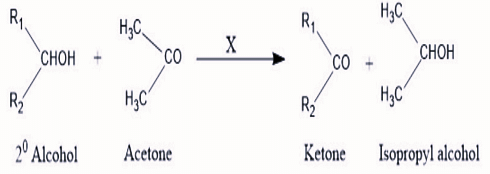A mixture of p-anisaldehyde and formaldehyde in the presence of concentrated sodium hydroxide resultsin:
- Sodium-p-methoxy benzene
- P-Methoxy benzyl alcohol
- p-Methoxy benzoyl alcohol
- p-Methoxy sodium benzoate
The Correct Option is B
Solution and Explanation
The question involves a reaction between p-anisaldehyde and formaldehyde in the presence of concentrated sodium hydroxide. This is an example of the Cannizzaro reaction, which typically occurs with aldehydes that do not contain an alpha hydrogen.
- In the Cannizzaro reaction, one molecule of the aldehyde is oxidized to an acid (or its salt), while another molecule is reduced to an alcohol. This reaction usually requires the presence of a strong base like sodium hydroxide.
- p-Anisaldehyde is C_6H_4(OCH_3)CHO, and it does not have any alpha hydrogen, making it a suitable candidate for the Cannizzaro reaction.
- Concurrently, formaldehyde, or HCHO, also lacks an alpha hydrogen. In this reaction setup, formaldehyde will also undergo a similar disproportionation.
- The result of the Cannizzaro reaction is that p-anisaldehyde is reduced to p-Methoxy benzyl alcohol (C_6H_4(OCH_3)CH_2OH), while formaldehyde gets oxidized to formic acid, which reacts with NaOH to give sodium formate.
Thus, the correct answer is p-Methoxy benzyl alcohol. This product results from the reduction part of the Cannizzaro reaction affecting p-anisaldehyde. The other options are not feasible products from this reaction because they don't align with the typical outcomes of a Cannizzaro reaction under these conditions.
Top Questions on carbonyl compounds
- Which of the following are neutral?
- KEAM - 2025
- Chemistry
- carbonyl compounds
- Acetone can be converted to 2-methylpropan-2-ol using:
- KEAM - 2025
- Chemistry
- carbonyl compounds
- The correct stability order of carbocations is
- JEE Main - 2024
- Chemistry
- carbonyl compounds
- According to Oppenauer Oxidation reaction, oxidation of secondary alcohol to ketone by reagent (X) in acetone takes place, what is "X" :

- GPAT - 2024
- Organic Chemistry
- carbonyl compounds
- The Gattermann-Koch reaction is used in the industrial preparation of benzaldehyde. The electrophile involved in this reaction is
- CUET (UG) - 2024
- Chemistry
- carbonyl compounds
Questions Asked in GPAT exam
- Which of the following alkaloids are found as salts of meconic acid?
- GPAT - 2025
- Introductory Pharmacognosy
Choose the correct match of laxative and its Mechanism of Action (MOA):

- GPAT - 2025
- Laxative
Match the following:
(P) Schedule H
(Q) Schedule G
(R) Schedule P
(S) Schedule F2
Descriptions:
(I) Life period of drugs
(II) Drugs used under RMP
(III) List of Prescription Drugs
(IV) Standards for surgical dressing
- GPAT - 2025
- Drug therapy
- Which of the following is used to evaluate disinfectant?
- GPAT - 2025
- Pathogens
Match the following:
(P) Tuberculosis (1) Bacterial
(Q) Diphtheria (2) Viral
(R) Yellow fever (3) Toxoids
(S) Malaria (4) Protozoal- GPAT - 2025
- Pathogens